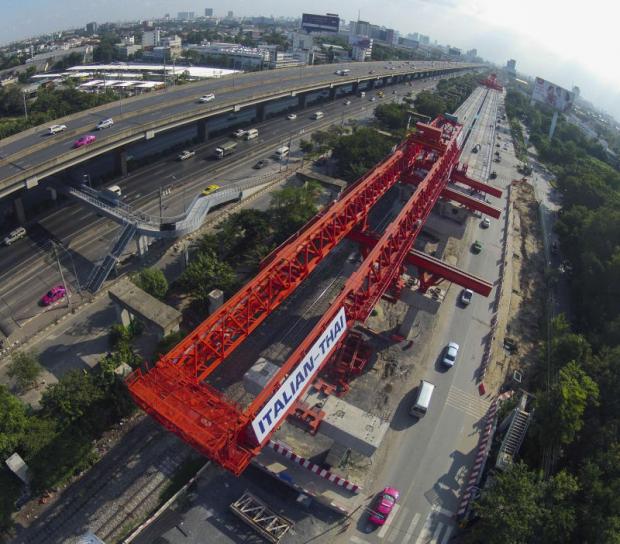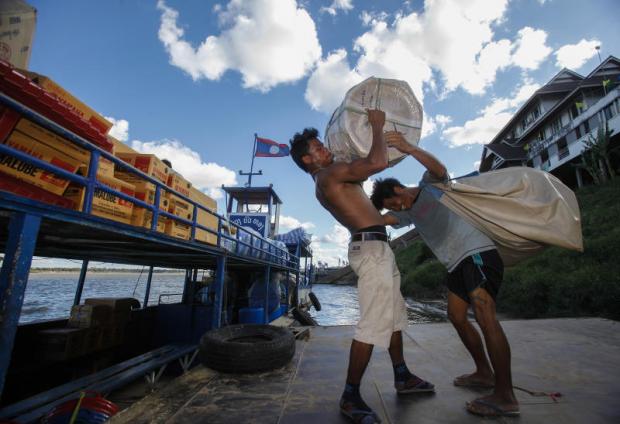
Thais are hopeful that the Year of the Goat will be an easier and more prosperous one than the rough and bumpy Year of the Horse.

An aerial view of the construction of the SRT Red Line (Bang Sue-Rangsit). Infrastructure investment is a key engine driving the economy in 2015. PATTARAPONG CHATPATTARASILL
However, many challenges lie ahead: the stubbornly stagnant economy hit by sluggish export growth, the lethargic domestic consumption, rising household debt and political uncertainty chief among them.
Hopes are pinned on the government's stimulus package, speedy budget disbursement and investment in infrastructure projects. Their success, however, depends largely on political stability and continuity of the government and its policies.
The Bangkok Post sums up the key challenges facing 2015, including the second phase of the eco-car scheme, which is expected to be hit by slow domestic and global demand, and the uncertain fate of the fourth-generation auction, crucial for the country's telecom infrastructure development. Given all these factors, the readiness of the private and public sectors for the advent of the Asean Economic Community at the end of this year seems questionable.
Economy
Even though Thailand is on course for better economic shape this year, underpinned by the government's stimulus measures, expedited budget disbursement and public spending on infrastructure projects, several headwinds — external factors in particular — lie ahead.
The economy suffered a sharp downturn last year as the protracted domestic political turmoil dented growth momentum in the first half, while export growth was dismal due to the fragile global economic recovery, hitting Thai exports hard.
Rubbing salt to the wound, domestic consumption could not maintain growth momentum as it continued to be dogged by an ever-increasing household debt, fuelled by the first-time car buyer scheme of the ousted Yingluck Shinawatra administration.
Economic growth declined by 0.1% year-on-year in the first half of 2014, while third-quarter growth registered at 0.6% on an annual basis. Policymakers also issued a stern warning that economic growth for the final quarter would expand at an annual rate of 2.5-3%, bringing full-year growth to less than 1%.
After much effort to shore up economic growth impetus, several government agencies and public policymakers are confident that GDP growth in 2015 will be at least 4%, boosted mainly by the government's promised investment in infrastructure development projects.
The government hopes its ambitious spending on developing basic infrastructure will have a "crowd-in" effect in attracting greater private investment and enhancing job creation.
The recent agreement with China to develop the double-track railway project offers a beacon of hope for better growth prospects this year.
Despite the low-base effect and recent government initiatives, several economists have pointed out that the 4% growth target for this year will be a challenge.
First and foremost, there have only been talks on infrastructure investment and not much action. Possible delays in infrastructure spending stemming from slow budget disbursement is a major downside risk for this year's economy. This could also dampen private investors' confidence as well as new investment incentives.
Second, domestic consumption could remain lukewarm given the high household debt, while a possible rise in value-added tax, currently capped at 7%, could cause consumption to dwindle further. The increase is aimed at improving the government's balance sheet.
Sluggish economic growth and swelling household debt could also increase non-performing loans in the year ahead, affecting the banking industry's asset quality. This might prompt banks to further tighten loan approvals.
Third, global economic recovery remains hazy and this will have negative implications for Thai exports as a slowdown in China, Europe and Japan means these major economies will import less for consumption or re-export to other countries.
Although US economic data indicate improvements in certain activities, this might be grounds for the US Federal Reserve to begin normalising Fed funds rate. If this happens, this could lead to volatility in global fund flows and Thailand will suffer from capital outflows as a result.
A rise in the Fed's funds rate could also pass on to Thailand's interest rates, potentially offsetting the recovery process due to higher debt-servicing costs for Thai consumers.

Workers load Thai goods for sale in Laos at a pier in Mukdahan province. Mukdahan is among the first five provinces designated as special economic zones, a government initiative to promote border trade. PATTARAPONG CHATPATTARASILL
Infrastructure
Infrastructure investment seems to be one of the vital lifelines Thailand is longing for to spur the fragile economy in 2015 after plans stalled for almost a year due to political mayhem.
The military-installed cabinet in October approved an eight-year infrastructure development programme for 2015-22 worth 3.3 trillion baht. The budget is well above the 2.4 trillion baht outlined by the National Council for Peace and Order (NCPO) in July, and the 2-trillion-baht plan of the previous government.
The current government's proposals, in fact, have a lot in common with the blueprint of the ousted Pheu Thai-led administration. However, they have been revised to take into account economic viability and funding alternatives besides government borrowing. The development time frame has also been extended to eight years from seven.
The most dramatic change is perhaps the switch from high-speed rail to a double-track service, and the new 1.435-metre standard gauge tracks suitable for trains running at 160-180 kilometres an hour on three routes. They will link the border province of Nong Khai to the industrial coastal region of Map Ta Phut in Rayong, a move that was advocated by experts but ignored by the Yingluck Shinawatra government.
The government is also committed to continuing the development of the mass transit system in Greater Bangkok. Plans are afoot to accelerate the construction of four projects covering 89 km including the Purple Line (Bang Yai-Bang Sue); the Blue Line extension (Bang Sue-Tha Phra/Hua Lamphong-Bang Khae); and the Green Line (Bearing-Samut Prakan). All construction should be completed by 2020.
The government is also calling for bids to build an 18.4-km route linking Mor Chit, Saphan Mai and Ku Kot in Pathum Thani. Construction is likely to start in 2016 and to be completed by 2020.
Six more routes totalling 144 km are also awaiting cabinet approval. They include the Orange Line from the Thailand Cultural Centre to Min Buri, the Pink Line from Khae Rai to Min Buri, the Yellow Line from Lat Phrao to Phattanakan, the Airport Rail Link from Don Mueang to Phaya Thai, the Light Red Line from Bang Sue via Hua Lamphong to Hua Mak, and the Dark Red Line from Rangsit to Thammasat University's Rangsit campus. Construction of the six routes is planned between 2015 and 2021.
A feasibility study is also under way for another 8-km project linking Bang Khae and Phutthamonthon Sai 4. It is planned to be completed in 2021.
At least 100 billion baht will be earmarked for investment in road construction in fiscal 2015, excluding mass transit routes, double-track rail lines and air transport, according to Deputy Prime Minister MR Pridiyathorn Devakula.
Nonetheless, MR Pridiyathorn said one vital challenge for the government's infrastructure investment in 2015 is a possible delay in budget disbursement.

A man walks past an ad for 4G high-speed service. The spectrum auction for 4G is expected to take place this year. SEKSAN ROJANAMETAKUL
AEC
The clock is ticking for the Asean Economic Community (AEC), as regional economic integration is just 360 days away — officially taking effect on Dec 31.
The AEC involves not only setting up free trade zones within Asean, but also creating a single market and production base in order to boost the competitiveness of Asean countries, and creating free mobility of goods, services, investment, capitalisation and skilled labour.
Since the pact was signed, the 10 Asean members — Brunei, Cambodia, Indonesia, Laos, Malaysia, Myanmar, the Philippines, Singapore, Thailand and Vietnam — have tried to create a single clear standard for professional qualification screening in order to help the free flow of seven key professions plus one sector (hotel and tourism) within member countries and ensure standards of quality.
The professional services are medicine, dentistry, nursing, engineering, architecture, surveying and accounting, in addition to the hotel and tourism sector.
The advent of regional economic integration has been in the limelight in recent years, but whether Thai people, businesses and the workforce understand the impact or are ready remains debatable.
Studies have found that Thai small and medium-sized enterprises (SMEs) and certain businesses, notably agriculture and labour-intensive industries, are the key areas of concern.
The latest survey by the Center for International Trade Studies under the University of the Thai Chamber of Commerce (UTCC) showed big companies believed they will on schedule.
But some 321,000 SMEs, representing 63% of the total 512,000 operators, said they might not be ready for the AEC's starting date on Dec 31, 2015. Such operators needed more time, to the end of 2016, for AEC integration, the survey found.
Most of these respondents said they needed a clearer government policy. Others said they did not understand much about the pact or had no time to adjust. Many believed their businesses had nothing much to do with the AEC, while some said they were willing to expand abroad if there was potential business and sufficient funding.
Aat Pisanwanich, director of the UTCC's Center for International Trade Studies, pointed out the sectors facing a gloomy outlook — the so-called sunset industries — include food, garments and textiles, seafood, wood products and furniture, computing and printing, gems and jewellery, and coffee.
But it is fortunate that compensation will come in the form of promising growth for products such as automotive and auto parts, TV sets and electric fans as well as air-conditioners, and rubber.
SEZs
Measures to promote border trade have been a priority for the military-installed government, particularly through the new special economic zone scheme.
The NCPO in July 2014 approved five locations designated for special economic zones (SEZs): Tak, Mukdahan, Songkhla, Sa Kaeo and Trat provinces which will span 10 districts and 36 tambons with a combined area of 2,932 square kilometres. The development plan, starting with Mae Sot in Tak and Aranyaprathet in Sa Kaeo, will be carried out from 2015-16.
To attract investors to the SEZs, a committee chaired by Prime Minister Prayut Chan-o-cha in November endorsed a proposal to offer 5 billion baht in soft loans to companies that agree to build in the zones.
The panel also agreed to offer investors promotional privilege packages and a one-stop service centre for labour.
The privileges would at least compare with those enjoyed by investors in the three southernmost provinces, such as an eight-year exemption from corporate tax and tariff waivers for imported machinery.
Workers from neighbouring countries will be allowed to cross the border as a day trip and return home in the evening and legally work in border areas without passports.
But despite the SEZ initiative being hailed by the private sector, concerns linger, particularly about rising electricity bills and higher wages.
The Federation of Thai Industries (FTI) warns that local operators could see a rise in the minimum wage in the near future, even though the government raised the daily minimum wage nationwide to 300 baht in 2013.
Power bills are primed to rise to five baht a unit in 2015, up from 3.96 baht in 2014.
International calls in Thailand remain expensive with limited options from a few operators, while 3G broadband services remain inefficient.
Vallop Vitanakorn, FTI vice-chairman, said he had doubts that state-promoted SEZs would attract business operators. Under the scheme, incentives will be offered to high-technology industries, but the government wants operators to employ workers from neighbouring countries even if they lack skills.
Thailand has suffered from a massive manufacturing labour shortage for a long time. "The problem will get very bad over the next three to five years because foreign workers will return to work in their home countries to enjoy their improving economies," said Mr Vallop.
The economies of Cambodia, Laos, Myanmar and Vietnam are estimated to grow an average of 6% this year and 6.5-7.5% in 2016. There are now 1.42 million workers from Myanmar, Laos and Cambodia registered with the Labour Ministry.
4G auction
The fourth-generation (4G) spectrum auction is a high hope for telecom operators to capitalise on the lucrative mobile data business to try to offset the staggering drop in voice service revenue and raise the telecom industry's competitiveness in the face of rising rivalry in the region.
Operators say 4G spectrum allocation is crucial to the development of the country's telecom infrastructure and transition to a digital economy following the government's national agenda.
Telecom operators, academics and telecom experts all agree on the critical need for the auction of 4G spectrum allocation, scheduled to take place this year. Some experts have voiced concerns that the telecom sector could face a setback if the auction is further delayed.
Previously, the National Broadcasting and Telecommunications Commission (NBTC) set the auction for the 4G mobile service on the 1800 and 900 megahertz spectrum for August and November, 2014.
But in June the junta ordered the NBTC to suspend the auction for another year, saying the regulator needed to amend several impractical sections of the Frequency Allocation Act (FAA) before the auction could take place.
On Dec 4 when Prime Minister Prayuth Chan-o-cha said he supported the spectrum auction plan for 4G wireless broadband service in 2015 as scheduled. This was a signal to the NBTC to continue preparing for the scheduled auction within seven months.
The regulator will start revising details of the auction for the 1800 and 900 megahertz spectrum with the new schedule for the auction planned for July. The revision will include the reserve price, the number of licences as well as the auction process. The amendment of the FAA will allow more transparency in the auction process.
The Information of Memorandum (IM) of the 1800 MHz already passed public hearing in April and was approved by the telecom committee in May. It has not yet been approved by the NBTC board. The IM of the 900 MHz allocation has not yet passed a public hearing.
Ericsson Thailand said the 4G licence auction needed to take place this year to develop infrastructure to support rapid growth in demand from both the telecom and broadcasting sectors.
Bunyati Kirdniyom, head of communications and regulatory affairs at Ericsson Thailand, said the fast-growing broadcasting industry could be affected if the telecom spectrum were not allocated in time, given expanding content consumption. As a result, spectrum allocation should be sequentially allocated to service providers.
Somchai Lertsuthivong, chief executive of AIS, concurred, saying that the 4G auction should take place this year to meet the rapidly growing demand of consumers.
True Move, the mobile business arm of True Corporation, was the first and only operator to commercially launch 4G LTE services in May 2014. The company expects 4G enabled-handsets to exceed 7 million units this year, up from 1 million at the end of 2014.
Eco-car 2
The eco-car phase two has been on a topsy-turvy ride over the past couple of years, after it was first raised by the Yingluck Shinawatra administration as part of its economic stimulus package in early 2013.
Due to the political mayhem that culminated in the House dissolution, there was a shortfall in Board of Investment (BoI) members, meaning that it was not until August 2013 that the BoI, with the Election Commission's consent, approved the second phase of the scheme.
The BoI had set March 31, 2014 as the deadline for applicants to submit eco-car investment plans and successfully drew 10 automakers, including the five existing eco-car manufacturers to build small, fuel-efficient cars.
The 10 projects envisioned output of a little over 1.58 million eco-cars, with investment of 110 billion baht more than the combined outlay from the five manufacturers in the first phase that began in 2007. Nissan, Honda, Mitsubishi, Suzuki and Toyota took part in the first phase, earmarking a combined 86.8 billion baht to produce 753,000 cars.
The newcomers — Mazda, Ford, General Motors, SAIC Motor-CP and Volkswagen — aim to invest 52 billion baht to make 828,000 vehicles a year in the second phase.
Nine of the automakers won BoI investment approval, leaving Volkswagen out of the picture.
Automakers with BoI investment approval are required to roll out their new eco-cars within 2019.
But given the country's bearish car sales, poor economy and weak domestic consumption, as well as the fragile global economy and higher competition from Indonesia's car industry, none of the BoI-approved automakers have yet to commit when they will commence production of new eco-cars.
The FTI projects Thailand's car production in 2015 will recover to 2.2 million vehicles, of which 1.2 million units are slated for export with the rest for the domestic market. Eco-car output was estimated at 272,550 units of the total.
Thailand was projected to end 2014 with overall car production of only 1.9 million vehicles, marking the first time since 2011 that production would miss 2 million.
Thailand's automotive output amounted to 2.45 million vehicles in 2012, driven by the first-time car buyer scheme and huge demand after massive floods hit several provinces in 2011. Output rose slightly in 2013 to 2.46 million vehicles, boosted by outstanding back orders under the scheme.
Domestic sales were projected at only 850,000 in 2014, a 36.1% fall from a year earlier. The drop was attributed mainly to the poor economy and delayed government spending.
The FTI said eco-car production under the first scheme rose consecutively between 2010 and 2013, from 60,000 to 355,000 units. Production was estimated at only 237,000 units at the end of 2014, falling for the first time after rising for four years.